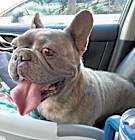Color
Gray/Blue/Silver/Salt & Pepper
Size
(when grown) Med. 26-60 lbs (12-27 kg)
Details
Good with dogs
House-trained
Spayed or Neutered
Shots are up-to-date
Story
You can fill out an adoption application online on our official website. Fill out an Adoption Application HEADLINER : Wherever we go, whatever we do, we’re gonna get through it together! With you for me and me for you We'll muddle through whatever we do, Together, together, wherever, wherever Together, wherever we go!... Meet Turkey Man Blue, one half of the Turkey Man Blue/Bella Wella Woo team. Turkey Man Blue responds best to just “Blue” (although at times it fits, he was just a little embarrassed by the nickname Turkey Man). HISTORY : Blue and Bella were turned into a local shelter together because their owner could no longer afford their care. Since Blue and Bella have been in foster care, they’ve put on some much needed weight (Blue certainly loves his food and takes his treats gently). PERSONALITY : Blue is a sensitive, calm, cool, collected, snuggle buddy, and, let’s face it, what dog doesn’t love a belly rub! Blue is all about the belly rubs. While he adores his companion Bella, Blue “worships” his people and will whine (but settle down quickly) when his people leave the room/house. Blue has quite the commanding bark! It’s hard to believe that such a bark comes from a dog his size. Neither Blue nor Bella are destructive when left alone. FAVORITE ACTIVITIES : Blue enjoys playing tug of war, keep away from, and bitey face with Bella. He would love a lap, any lap, “your” lap to curl up in. MEDICAL ISSUES : None. WHAT WOULD BE THE BEST KIND OF HOME : While Blue gets along well with dogs his size or smaller, large dogs make him nervous. He would very much love a home where he and Bella could be the only pups vying for their adopter’s attention. Blue did live with a cat in his previous home and, therefore, would probably not mind sharing a home with a dog savvy kitty, however, Blue’s current foster does not currently own a cat and is unable to confirm as to whether or not this statement is true. Blue would also love a home where his person is home most of the day. Blue could use some leash work on pulling. ADDITIONAL COMMENTS: Blue and Bella love and look forward to car rides. They settle right in and you don’t hear a peep from either one the entire ride. Application Fees, Adoption Donations and Rescue Policy: Please know that 100% of our fees and donations pay for the costs of rescuing dogs. These include but are not limited to pull fees from shelters, veterinary examinations, vaccinations, medications and care, microchips, neuter/spay surgeries, heartworm treatments, behavior evaluations, and foster care, as needed. Important notes before applying. Adopters must have their primary residence in one of the following states: Pennsylvania, Ohio, New Jersey, Delaware, Maryland, West Virginia, Virginia, and parts of North Carolina. We will not adopt giant breed dogs to renters. Homes with children under 6 years of age will not be approved for adoption. Homes with children should have a fenced yard. Pets currently in the applicant's home must have a history of appropriate veterinary care. Homes with intact dogs will not be approved for adoption. Proof of any of the following exceptions is required: The intact dog is a working member of a law enforcement, or search and rescue/recovery team. The intact dog is registered under the auspices of the American Kennel Club and is actively being shown. A veterinarian has determined the sterilization procedure would harm the intact dog. We believe in Force Free Training Methods and do not approve of methods or devices using pain or force to control the dog, or to deter undesirable behavior. Homes with highly varnished steps must have carpeting, securely fixed stair treads, or a non-skid surface. **We encourage you to remediate potential safety issues while your application is under review, prior to the home visit. For additional information please review our FAQs or contact mastiffstomutts@gmail.com **Mastiffs To Mutts Rescue reserves the right to approve or deny any adoption that occurs through this organization without disclosure. We reserve the right to make exceptions for special circumstances. **PA Kennel License: 05845Visit this organization's web site to see any additional information available about this pet. March 20, 2025, 12:10 pm


















